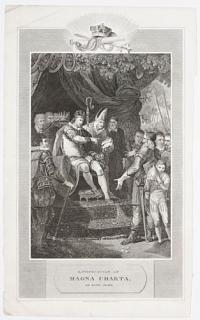
Ratification of Magna Charta, by King John.
Mortimer Pinx.t Wilson Sculp.
Published by J. & J. Cundee, Albion Press, London, 1813.
Engraving. 420 x 255mm (16½ x 10"). Creasing, nicks around edges.
King John seated on throne below canopy, pointing at the Magna Carta held by churchman. King John confronted by his barons in 1215. Despite the title it was only after the death of John in 1216 that either Crown or nobility attempt to abide by the terms of the document.
[Ref: 28942] £60.00
(£72.00 incl.VAT)
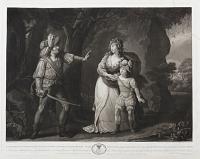
Margaret, Queen of King Henry VI, with her Son Prince Edward, attacked by a Robber. A.D. 1463. Acta Historica Reginarum Angliae. Plate IV. Engraved from the Original Drawing, of the same dimensions in the Possession of Mr. V. Green. To Her Serene Highness Louisa, Carolina, Henrietta, Hereditary Princess of Hesse Darmstadt, &c. This Plate is (by permission) Most humbly Dedicated, by Her Serene Highness's Most Devoted and Obedient humble Servant Valentine Green.
Drawn by J. Gerhard Huck. Engraved by V. Green Mezzotinto Engraver to his Majesty & the Elector Palatine.
Publish'd June 4.th 1790, by V. & R. Green No. 29 Newman Street, Oxford Street, London.
Fine mezzotint, platemark 490 x 625mm (19¼ x 24½"). Slight creasing on left. Large margins, uncut.
Margaret of Anjou with her son Edward of Westminster (also known as Edward of Lancaster). This scene may depict a scene whereby Margaret, fleeing the Yorkists, is supposed to have encountered an outlaw who aided the queen and her son upon discovering their identities. Plate four of 'Acta Historicae Reginarum Angliae' by the celebrated mezzotinter Valentine Green (1739-183) from drawings by his former student Johann Gerhard Huck (c.1759-1811), with parallel text in French. Whitman: 251 II of II; CS: 153.4 Ex Collection of Christopher Lennox-Boyd.
[Ref: 23050] £330.00

Marquis of Granby relieving the Distressed Soldier & his Family.
London, Printed for R. Sayer & J. Bennett, No.53 Fleet Street, as the Act directs, 2.d Feb.y 1780.
Coloured mezzotint. Plate 152 x 114mm. 6 x 4½".
Granby seen whole-length on horseback to left in landscape, addressing dejected soldier sitting at side of road, his wife and two children standing, imploring Granby; further soldiers on horseback seen beyond. John Manner, Marquess of Granby (1721-1770), was an army officer and politician; he was a general in the Seven Years' War. CS: undescribed.
[Ref: 24065] £130.00
(£156.00 incl.VAT)
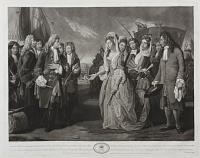
Queen Mary, reviewing the Militia of London and Westminster, in Hyde-Park, A.D. 1692. Acta Historica Reginarum Angliae. Plate XI. Engraved from the Original Drawing, of the same dimensions in the Possession of Mr. V. Green. To Her Royal Highness Frederica, Sophia, Wilhelmina, Princess of Orange, This plate is (by Permission) Most Humbly Dedicated By Her Royal Highnesses Most Devoted and Obedient humble servant Valentine Green.
Drawn by J. Gerhard Huck. Engraved by V. Green Mezzotinto Engraver to his Majesty & the Elector Palatine.
Publish'd October 18th 1791 by V. & R. Green No. 29 Newman Street, Oxford Street, London.
Fine mezzotint, rare, platemark 490 x 625mm (19¼ x 24½"). Creasing; large margins, uncut.
Mary II surveying troops in Hyde Park. The main event of 1692 was the War of the Grand Alliance between the allied forces of England and the Dutch Republic, and the French. Plate eleven of 'Acta Historicae Reginarum Angliae' by the celebrated mezzotinter Valentine Green (1739-183) from drawings by his former student Johann Gerhard Huck (c.1759-1811), with parallel text in French. Whitman: 258 II of II; CS: 153.11. Ex Collection of Hon Christopher Lennox-Boyd.
[Ref: 23086] £420.00
![Reception of Her Royal High. The Princesse of Orange as queene of Great Britain [parallel text in Dutch]](img-thumbnail/jpegs/42379.jpg)
Reception of Her Royal High. The Princesse of Orange as queene of Great Britain [parallel text in Dutch]
R. de Hooge fec.
Tot Leiden By J. Tangena gedruckt met Privilegi [1689]
Etching, sheet 475 x 570mm (18¾ x 22½"). Trimmed inside platemark; repaired vertical and horizontal folds barely visible from front, two cuts from bottom edge to facilitate folding;
A grand image of a new age. The arrival in England of Mary II, daughter of James II who married William of Orange. In 1688 William invaded Britain in the Glorious Revolution, deposing James II and becoming William III, and Mary followed in 1689. Here a large crowd welcomes her while ships in the middle ground and background fire salutes. Various elements are numbered 1-23 although there is no letterpress identification in this state. Etching by Romeyn de Hooghe (1645-1708), exponent of the late Dutch Baroque best known for his political caricatures of Louis XIV and his prints glorifying William III and the Glorious Revolution such as this. De Hooghe's output as an artist was broad, however, and he had other talents and responsibilities: in 1689 he was placed in charge of obtaining building materials for the royal hunting lodge of Het Loo; the same year he became a Doctor of Law at Harderwijk University; he designed ceiling paintings for municipal buildings and church windows; and he wrote several political and historical treatises. See C Mendez & Grosvenor Prints: "Restoration & Revolution 2002" No 28; Landwehr: p153.
[Ref: 42379] £950.00
![[Departure of Marry II from Holland.] Vetrek van haar Koning lyke Hoogheid Mevrouw de Prinses van Oranjen uit Holland den 20 Februar 1689.](img-thumbnail/jpegs/42942.jpg)
[Departure of Marry II from Holland.] Vetrek van haar Koning lyke Hoogheid Mevrouw de Prinses van Oranjen uit Holland den 20 Februar 1689.
Carolus Allard Excudit Cum Privilegie. [n.d., c.1689].
Engraving. Sheet: 295 x 255mm (11½ x 10"). Trimmed and tipped into album sheet.
A scene showing Mary, wife of William of Orange leaving Holland to be crowned Mary II of England.
[Ref: 42942] £320.00
![[Mary II on her deathbed, with William III grieving and courtiers offering condolences]](img-thumbnail/jpegs/42798.jpg)
[Mary II on her deathbed, with William III grieving and courtiers offering condolences]
[Romeyn de Hooghe, 1695]
Etching, sheet 445 x 585mm (17½ x 23"). Trimmed from large broadside, losing text below; three folds.
Mary II on her deathbed. On 24 November 1694 she collapsed with a stroke from which she never recovered, and by Christmas of that year it was clear she was suffering from smallpox. She died at Kensington Palace on the morning of 28 December 1694, and her body was embalmed that day as a precaution against the putrescent effects of smallpox. Top half of a broadside on the death of Mary II in 1694 etched by Romeyn de Hooghe (1645-1708), Dutch Baroque printmaker best known for his political caricatures of Louis XIV and his prints glorifying William III and the Glorious Revolution. Landwehr p.174.
[Ref: 42798] £590.00
![[Title page to series of prints depicting the funeral of Mary II]](img-thumbnail/jpegs/42807.jpg)
[Title page to series of prints depicting the funeral of Mary II] Funeralia Mariae Reginae, Talia Soeva Sonat: per Rostra, Palatia, Templa, Seminecem [...]
Rom: de Hooge I.V.D. et Com: R: Auct.
D. Persoy Excud: Cum Privilegio [c.1691]
Etching, rare; sheet 300 x 185mm (11¾ x 7¼"). Trimmed. Tipped into album sheet.
Mary II (1662-94) privately expressed the wish for a simple funeral, but following her death from smallpox she was given an elaborate burial in Westminster Abbey and the most lavish funeral procession ever held for an English monarch, as depicted in a series of prints by Romeyn de Hooghe to which this is the frontispiece. De Hooghe (1645-1708) was a Dutch Baroque printmaker best known for his political caricatures of Louis XIV and his prints glorifying William III and the Glorious Revolution. Landwehr p.171
[Ref: 42807] £320.00
![[The funeral of Mary II] Bed van Parade [...]](img-thumbnail/jpegs/61405.jpg)
[The funeral of Mary II] Bed van Parade [...]
[Romeyn de Hooghe]
By Pieter Persoy met Previlegie [1695].
Rare etching. Sheet 240 x 300mm (9½ x 11¾"). Trimmed close to printed border on left, lacking letterpress key.
Mary II's regalia on display after her death in 1694. Plate from Samuel Gruterus, 'Funeralia Mariae II Britanniarum' (Haarlem, 1695), which depicted episodes from the funeral of Mary II (1662-94). Although Mary had privately expressed the wish for a simple funeral, she was buried with elaborate ceremony in Westminster Abbey, and her funeral procession was the largest ever held for an English monarch. Etched by Romeyn de Hooghe (1645-1708), Landwehr Bookplates 87.
[Ref: 61405] £180.00
(£216.00 incl.VAT)
![[The funeral of Mary II] Lectisternium Ostentiserum. Bed van Parade [...]](img-thumbnail/jpegs/42576.jpg)
[The funeral of Mary II] Lectisternium Ostentiserum. Bed van Parade [...]
[Romeyn de Hooghe]
By Pieter Persoy met Previlegie [1695].
Rare etching with letterpress. heet 325 x 285mm (12¾ x 11¼"). Trimmed; fold through middle as normal.
Mary II's regalia on display after her death in 1694. Plate from Samuel Gruterus, 'Funeralia Mariae II Britanniarum' (Haarlem, 1695), which depicted episodes from the funeral of Mary II (1662-94), queen of England, Scotland and Ireland. Although Mary had privately expressed the wish for a simple funeral, she was buried with elaborate ceremony in Westminster Abbey, and her funeral procession was the largest ever held for an English monarch. Etched by Romeyn de Hooghe (1645-1708), exponent of the late Dutch Baroque best known for his political caricatures of Louis XIV and his prints glorifying William III and the Glorious Revolution. De Hooghe's output as an artist was broad, however, and he had other talents and responsibilities: in 1689 he was placed in charge of obtaining building materials for the royal hunting lodge of Het Loo; the same year he became a Doctor of Law at Harderwijk University; he designed ceiling paintings for municipal buildings and church windows; and he wrote several political and historical treatises. Landwehr Bookplates 87
[Ref: 42576] £420.00
![[Entrance to Whitehall Palace during preparations for the funeral of Mary II]](img-thumbnail/jpegs/42595.jpg)
[Entrance to Whitehall Palace during preparations for the funeral of Mary II] Rou Poort van Withal [...]
[Romeyn de Hooghe]
P Persoy Exc. Cum Previlegie [1695]
Etching with letterpress, sheet 345 x 285mm (13½ x 11¼"). Trimmed; fold through middle as normal.
Plate from Samuel Gruterus, 'Funeralia Mariae II Britanniarum' (Haarlem, 1695), which depicted episodes from the funeral of Mary II (1662-94), queen of England, Scotland and Ireland, showing four sedan chairs in background. Although Mary had privately expressed the wish for a simple funeral, she was buried with elaborate ceremony in Westminster Abbey, and her funeral procession was the largest ever held for an English monarch. Etched by Romeyn de Hooghe (1645-1708), exponent of the late Dutch Baroque best known for his political caricatures of Louis XIV and his prints glorifying William III and the Glorious Revolution. De Hooghe's output as an artist was broad, however, and he had other talents and responsibilities: in 1689 he was placed in charge of obtaining building materials for the royal hunting lodge of Het Loo; the same year he became a Doctor of Law at Harderwijk University; he designed ceiling paintings for municipal buildings and church windows; and he wrote several political and historical treatises.
[Ref: 42595] £380.00
![[Mary II on her deathbed]](img-thumbnail/jpegs/42808.jpg)
[Mary II on her deathbed] Sterven der Koninginne [...]
[Romeyn de Hooghe]
P Persoy Exc. Cum Previlegie [1695]
Etching with letterpress, sheet 285 x 285mm (11¼ x 11¼"). Trimmed; fold through middle as normal.
Mary II attended on her deathbed by William III, Archbishop of Canterbury Thomas Tenison, doctors, and courtiers. Plate from Samuel Gruterus, 'Funeralia Mariae II Britanniarum' (Haarlem, 1695), which depicted episodes from the funeral of Mary II (1662-94), queen of England, Scotland and Ireland. Although Mary had privately expressed the wish for a simple funeral, she was buried with elaborate ceremony in Westminster Abbey, and her funeral procession was the largest ever held for an English monarch. Etched by Romeyn de Hooghe (1645-1708), exponent of the late Dutch Baroque best known for his political caricatures of Louis XIV and his prints glorifying William III and the Glorious Revolution. De Hooghe's output as an artist was broad, however, and he had other talents and responsibilities: in 1689 he was placed in charge of obtaining building materials for the royal hunting lodge of Het Loo; the same year he became a Doctor of Law at Harderwijk University; he designed ceiling paintings for municipal buildings and church windows; and he wrote several political and historical treatises. Landwehr p.172
[Ref: 42808] £280.00
(£336.00 incl.VAT)
![[Burial of Mary II at Westminster Abbey]](img-thumbnail/jpegs/42809.jpg)
[Burial of Mary II at Westminster Abbey] Excell.mo Nob.mo D.o D.o Algernoni Com: d'Essex Vice Com: de Malden. [...]
[Romeyn de Hooghe]
P Persoy Exc. Cum Previlegie [1695]
Etching, sheet 450 x 595mm (17¾ x 23½"). Trimmed, losing text below image; creasing not visible from front.
Plate from Samuel Gruterus, 'Funeralia Mariae II Britanniarum' (Haarlem, 1695), which depicted episodes from the funeral of Mary II (1662-94), queen of England, Scotland and Ireland. Although Mary had privately expressed the wish for a simple funeral, she was buried with elaborate ceremony in Westminster Abbey, and her funeral procession was the largest ever held for an English monarch. Etched by Romeyn de Hooghe (1645-1708), exponent of the late Dutch Baroque best known for his political caricatures of Louis XIV and his prints glorifying William III and the Glorious Revolution. De Hooghe's output as an artist was broad, however, and he had other talents and responsibilities: in 1689 he was placed in charge of obtaining building materials for the royal hunting lodge of Het Loo; the same year he became a Doctor of Law at Harderwijk University; he designed ceiling paintings for municipal buildings and church windows; and he wrote several political and historical treatises. Landwehr p.182
[Ref: 42809] £550.00
![[Funeral Procession of Mary II]](img-thumbnail/jpegs/42810.jpg)
[Funeral Procession of Mary II]
[Romeyn de Hooghe]
P Persoy Exc. Cum Previlegio [1695]
Three etched sheets, rare; each approx 445 x 570mm (17½ x 22½"). Each sheet trimmed in half and pasted one half above the other, with letterpress trimmed and pasted verso; vertical folds to each sheet. Loss on left side 1st plate.
Complete series of views depicting the extraordinary funeral procession for Mary II, which proceeded from the Banqueting House in Whitehall Palace to Westminster Abbey. It remains the largest ever held for an English monarch. Plates from Samuel Gruterus, 'Funeralia Mariae II Britanniarum' (Haarlem, 1695), which depicted episodes from the funeral of Mary II. Etched by Romeyn de Hooghe (1645-1708), exponent of the late Dutch Baroque best known for his political caricatures of Louis XIV and his prints glorifying William III and the Glorious Revolution. De Hooghe's output as an artist was broad, however, and he had other talents and responsibilities: in 1689 he was placed in charge of obtaining building materials for the royal hunting lodge of Het Loo; the same year he became a Doctor of Law at Harderwijk University; he designed ceiling paintings for municipal buildings and church windows; and he wrote several political and historical treatises. Landwehr pp.176-181. Numbered 1-78. See C Mendez & Grosvenor Prints "Restoration & Revolution 2002" No 35.
[Ref: 42810] £950.00
view all images for this item
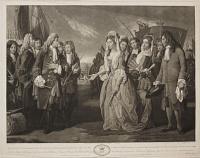
Queen Mary II, reviewing the Militia of London and Westminster, in Hyde-Park, A.D. 1692. La Reine Marie II, Passant en revue la Milice de Londres et de Westminster, a Hyde-Park. A.D. 1692. To Her Royal Highness Frederica, Sophia Wilhelmina, Princess of Orange, This Plate is (by Permission) Most Humbly Dedicated by Her Royal Highness, Most Devoted and Obedient humble Servant Valentine Green.
Drawn by J. Gerhard Huck. Engraved by V. Green Mezzotint Engraver to his Majesty & the Elector Palantine. Engraved from the original drawing of the same dimensions in the possession of Mr. V. Green.
Publish'd Oct.r 18th, 1791. by V. & R. Green, Newman Street, Oxford Street, London.
Mezzotint. 485 x 620mm (19 x 24½") Diagonal crease top right, top and bottom margins creased and chipped, tear entering inscription area.
Plate XI of 'Acta Historica Reginarum Angliae'.
[Ref: 3340] £480.00
![[Departure of Mary Queen of Scot's to France, when a Child.] [&] [Mary, Queen of Scots Leaving Scotland]](img-thumbnail/jpegs/56632.jpg)
[Departure of Mary Queen of Scot's to France, when a Child.] [&] [Mary, Queen of Scots Leaving Scotland]
Painted by R. Westall. R.A. Engraved by F. Bartolozzi. R.A.
London. Publish'd, August 2. 1794, by W Dickinson.
Pair of stipple proofs, plate 375 x 470mm (14¾ x 18½"). Repaired creases and tears mainly in margins. Small margins.
Pair of stipples depicting Mary Stuart (1542–1587) leaving for France when she was five and fleeing to England after she was forced to abdicate in favour of her one-year-old son on 24th July 1567.
[Ref: 56632] £380.00
view all images for this item
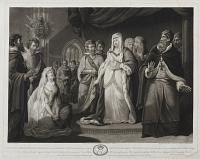
Queen Matilda soliciting the Empress Maude for the Release of her Husband King Stephen from Imprisonment. A.D. 1141. Acta Historica Reginarum Angliae. Plate I. Engraved from the Original Drawing, of the same dimensions in the Possession of Mr. V. Green. To Her Most Serene Highness Elizabeth Augusta Electress Palatine Duchess of Bavaria, &c. &c. &c. This Plate is (by Her Gracious permission) Most humbly Dedicated, by Her Most Serene Highness's Most Devoted and Obedient humble Servant Valentine Green.
Drawn by J. Gerhard Huck. Engraved by V. Green Mezzotinto Engraver to his Majesty & the Elector Palatine.
Publish'd March 21.st 1789 by V. & R. Green No. 29 Newman Street, Oxford Street, London.
Rare mezzotint, platemark 490 x 625mm (19¼ x 24½"). Creasing on left. Uncut large margins.
Matilda of Boulogne, (1103?-1152), wife of Stephen, King of England, solicits the Empress Matilda (1102-67) for her husband's release. Civil war had broken out on the Empress's landing in England in 1140, and Stephen was taken prisoner at the battle of Lincoln. After the Empress's half-brother Robert, Earl of Gloucester, waas captured by the king's supporters, an exchange of prisoners eventually took place. Plate one of 'Acta Historicae Reginarum Angliae' by the celebrated mezzotinter Valentine Green (1739-183) from drawings by his former student Johann Gerhard Huck (c.1759-1811), with parallel text in French. Whitman: 248.2; CS: 153.2 II of II. Ex Collection of Christopher Lennox-Boyd.
[Ref: 23040] £230.00
(£276.00 incl.VAT)
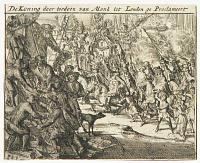
De Koning door toedoen van Monk tot Londen ge Proclameert.
[n.d. c.1685.]
Etching. 90 x 115mm. 3½ x 4½".
George Monck used this time wisely as Governor of Scotland to readdress the state of the British Isles. Concerned that the nation would descend into anarchy, he and his army marched into the City of London and forced the Rump Parliament to re-admit members of the Long Parliament who served under Charles II. Monck's efforts contriubuted to the restoration of Charles as monarch. Charles II arrived in London on his 30th Birthday, 29th May 1660. Anonymous engraving probably Dutch from a Broadside that would have small engravings arranged in rows or alternatively around one central etching.
[Ref: 17464] £65.00
(£78.00 incl.VAT)
![[James Scott, Duke of Monmouth greeting his supporters.]](img-thumbnail/jpegs/42794.jpg)
[James Scott, Duke of Monmouth greeting his supporters.]
Engraving, sheet 165 x 220mm (6½ x 8½"). Glued to album sheet at edges.
A naive engraving of a scene showing James Scott, Duke of Monmouth greeting his followers, the faces are copies of well-known portraits Monmouth's is a copy of Blooteling's mezzotint after Peter Lely.
[Ref: 42794] £260.00
(£312.00 incl.VAT)
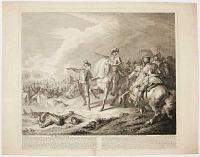
The Battle of Naisby. This Battle which gave the fatal turn to the Kings Affairs happen’d on the 14 June 1645, the first charge was given by the right wing of Horse & Foot commanded by Prince Rupert & his Brother, who bore down all before them; the left wing & the Northern Horse engaging Cromwell & the Enemies right wing against odds of num.rs & ye advantage Ground were put to Flight...caused them all to turn their Horses & ride upon ye Spur as if every Man was to shift for himself after this Disorder ye K. not being able to prevail w.th his Troops to rally & charge ye Enemy He retreated as well as He could & left Fairfax entire Master of the Field. [Translated into French].
Parrocel Pinx. Dupuis Sculp.
London 1727.
Fine etching and engraving, paper watermarked. Plate 412 x 470mm (16¼ x 18½"). Some creasing and scuffing to paper.
The Battle of Naseby was the key battle of the first English Civil War, where the main army of King Charles I was destroyed by the Parliamentarian New Model Army commanded by Sir Thomas Fairfax and Oliver Cromwell. Extensive letterpress description below image. See NAM: 35605.
[Ref: 28993] £240.00
(£288.00 incl.VAT)

Naumachy (or Sham Sea fight) on the Serpentine, and display of Fireworks in Celebration of the Grand Jubilee. A.t 1st 1814.
[n.d., 1814.]
Rare aquatint. Sheet 285 x 305mm (11¼ x 12"), ink mss. ownership inscription on reverse dated 'September 19th 1814'. Trimmed within plate at sides, repaired tears in left and right edge.
A printed souvenir of the event, which saw a mock sea battle between 42 miniature warships, 40 feet long and 12 feet wide, each carrying ten guns and thirty crew, all of which had to be constructed on site. Provenance: Athelhampton House, Dorset.
[Ref: 52924] £390.00

The Ceremony of Lord Nelson's Interment in St Pauls Cathedral, Jan.y 9.th 1806.
Drawn by W.m Orme from a sketch made on the sport by the Rev.d Holt Waring. J. Clark & J. Hamble sculp.t.
Published & Sold Feb.y 20.th 1806 by Edw.d Orme Bond Street, the corner of Brook Street, London.
Hand-coloured aquatint, watermark 1804. Plate: 505 x 370mm (20 x 14½''). Central horizontal crease as issued, staining and tear along crease at edges.
An interior view of St Paul's Cathedral showing the funeral of Lord Nelson in 1806. A plate from 'Orme's Graphic history of the life, exploits, and death of Horatio Nelson...' 1806. Abbey Life 327.
[Ref: 50897] £240.00
(£288.00 incl.VAT)
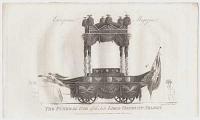
The Funeral Car of the late Viscount Nelson European Magazine.
Engraved by S. Rawle.
Published by J. Asperne, at the Bible, Crown & Constition, Cornhill, March 1st 1806.
Engraving. Sheet 130 x 220mm (5¼ x 8¾"). Large margins on 3 sides.
The ornate funeral car designed to suggest the battleship Victory on which Nelson died, the car was decorated with a figurehead representing Fame. The coffin inside was made from the mainmast of 'l'Orient', the French flagship blown up during the Battle of the Nile (1798).
[Ref: 59807] £65.00
(£78.00 incl.VAT)
![[Lord Nelson] The Magnificent Funeral Car.](img-thumbnail/jpegs/61303.jpg)
[Lord Nelson] The Magnificent Funeral Car. Built for the sole purpose of Conveying the Remains of Vice Admiral Lord Viscount Nelson, to S.t Pauls Cathedral for Interment, on Thursday the 9.th of Jan.y 1806.
Publish'd by Laurie & Whittle, N.o 53, Fleet Street, London, Jan.y 28 1806.
Coloured etching with engraving, watermark W. Elgar. Sheet 205 x 265mm (8 x 10½"). Trimmed, repaired tears, bottom left corner rebuilt, surface soiling. Damaged.
The funeral car, black-canopied and furnished with bow section and sterncastle as of a warship, flying white ensign at half-mast.
[Ref: 61303] £180.00
(£216.00 incl.VAT)
![[Funeral Procession of Lord Viscount Nelson, Jan.y 9th 1806.]](img-thumbnail/jpegs/39092.jpg)
[Funeral Procession of Lord Viscount Nelson, Jan.y 9th 1806.]
[W.M. Craig del. Edw.d Orme excu.t. J. Godby sculp.t.]
[Published & Sold Jan.y 12 1806 by Edwd Orme Engraver, Printseller to the King & Royal Family, 59, Bond Street, London.]
Coloured aquatint, sheet 270 x 395mm (10¾ x 15½"). Trimmed to image, losing all letters, tear in right edge.
Nelson's hearse in Ludgate Street, with St Paul's Cathedral behind. The design mimicked the 'Victory', with a figurehead and ship's stern. This example is apparently an early state: most examples have the shadows of spectators in the upper windows of Ludgate Street, all blank here. A plate from 'Orme's Graphic History of the Life, Exploits, and Death of Horation Nelson', published only three days after the funeral. Abbey Life in England 327.
[Ref: 39092] £180.00
(£216.00 incl.VAT)
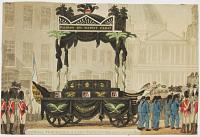
Funeral Procession of Lord Viscount Nelson, Jan.y 9th 1806.
W.M. Craig del. Edw.d Orme excu.t. J. Godby sculp.t.
Published & Sold Jan.y 12 1806 by Edwd Orme Engraver, Printseller to the King & Royal Family, 59, Bond Street, London.
Hand-coloured aquatint. Plate: 330 x 430mm (13 x 17''). Central vertical crease as issued.
Nelson's hearse in Ludgate Street, with St Paul's Cathedral behind. The design mimicked the 'Victory', with a figurehead and ship's stern. A plate from 'Orme's Graphic History of the Life, Exploits, and Death of Horation Nelson', published only three days after the funeral. Abbey Life 327.
[Ref: 39094] £280.00
(£336.00 incl.VAT)
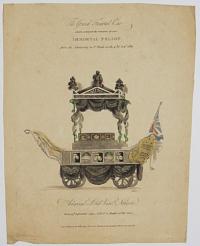
The Grand Funeral Car which conveyed the remains of our Immortal Nelson from the Admiralty to St Pauls on the 9.th of Jan.y 1806. Admiral Lord Visc.t Nelson. Born 29th September 1758 _ Killed in Battle 21st Oct.r 1805.
Bragg sc.
London Published by John Wallis Jun.r Fleet Street & Sold wholesale by Champante and Whitrow, Jewry Street 1806.
Coloured aquatint, rare; sheet 310 x 240mm (12¼ x 9½"). Some creasing.
Nelson's hearse, mimicking the 'Victory', with a figurehead and ship's stern.
[Ref: 39096] £260.00
(£312.00 incl.VAT)
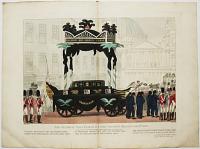
Funeral Procession of Lord Viscount Nelson, Jan.y 9th 1806.
W.M. Craig del. Edw.d Orme excu.t. J. Godby sculp.t.
Published & Sold Jan.y 12 1806 by Edwd Orme Engraver, Printseller to the King & Royal Family, 59, Bond Street, London.
Fine hand-coloured aquatint. Plate: 330 x 430mm (13 x 17'') with very large margins. Central vertical crease as issued.
Nelson's hearse in Ludgate Street, with St Paul's Cathedral behind. The design mimicked the 'Victory', with a figurehead and ship's stern. A plate from 'Orme's Graphic History of the Life, Exploits, and Death of Horation Nelson', published only three days after the funeral. Abbey Life 327.
[Ref: 50898] £280.00
(£336.00 incl.VAT)
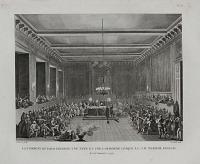
La Commune de Paris Décerne une Épée et une Couronne Civique à C.J.W. Nesham, Anglais. Le 15 Janvier 1790.
Prieur inv. & del. Berthalt Sculp.
[Paris: Auber, 1804.]
Etching. 240 x 280mm (9½ x 11").
Christopher John Williams Nesham (1771-1853) was a British naval officer who was in Normandy when the French Revolution broke out. Caught in local unrest he saved a corn merchant from being lynched for sending his flour to Paris. The Paris Commune summoned him to Paris and presented him with a uniform sword of the national guard and placed a civic crown on his head. During the course of his career he served with Edward Pellew, Admiral Duncan at Camperdown and Sir George Cockburn at the capture of Martinique (from the French). He was promoted to Admiral in 1852, over sixty years after the events shown here. Published in the 'Collection complète des tableaux historiques de la révolution française'.
[Ref: 28242] £120.00
(£144.00 incl.VAT)
![[Never-extinguished flame]](img-thumbnail/jpegs/47102.jpg)
[Never-extinguished flame] Societatis Londini Rei Antiquariae Studiosa. Ian: Ao MDCCXVIII.
[1718]
Engraving with original hand-colouring, sheet 235 x 185mm (9¼ x 7¼"). Trimmed and glued to backing sheet.
Print from an antiquarian publication, seemingly reproducing a discovery.
[Ref: 47102] £130.00
(£156.00 incl.VAT)
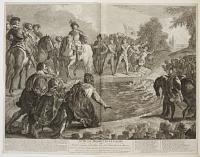
Sr.Hugh Middleton's Glory. or The first issuing of the Water into the New-River-Head, before the Lord Mayor, Aldermen, Recorder and a Worthy Company who stood to behold it. Humbly inscrib'd to the Directors of the New River Company by Geo. Bickham. Mr. Middleton undertook to bring a River from Chadwell and Amwell to the north side of London, near Islington; where he made a large Cistern to receive it...Clerk of the works, reach me to the book to show, How many Arts from such a labour flow First here’s the Overseer, this try’d Man An ancient soldier, and an Artizan...And with thy Chrystal murmers strook together Bid all they true well-wishers welcome hithers, At which words the flood gates flow open, the stream ran gallantly into the Cistern, Drums and Trumpets sounding in triumphal manner, and a Peal of Chambers gave ful Issue to the intended Entertainment.
London, Printed for Rob.t Sayer, Map & Printseller No.53 Fleet Street as the Act directs 1 Sep.r 1772.
Etching and engraving. 427 x 552mm (16¾ x 21¾"). Trimmed and folded. Laid on album sheet on one side.
Sir Hugh Myddleton (1560?-1631) observing the first issue of the New River, a canal which brought water from Chadwell and Amwell in Hertfordshire to a reservoir in Clerkenwell whence it supplied the City of London. Work was completed in 1613. The following year Myddleton sold shares in the undertaking and in 1619 the New River Company was incorporated. Extensive letterpress text below describing the scene and the history of the New River project.
[Ref: 28983] £360.00
![[The English Parliament in Session; Edward I (?) presiding.]](img-thumbnail/jpegs/26869.jpg)
[The English Parliament in Session; Edward I (?) presiding.]
[Anon., British, n.d., c.1800.]
Etching, sheet 285 x 195mm. 11¼ x 7¾". Trimmed within plate; corner tips chipped and glue-stained.
The King at upper centre seated on a throne, the two Archbishops (of Canterbury and York, their arms above) to his right; seated in the chamber (presumably Westminster Hall) in front of the monarch are (to left) the Bishops, facing (right) assembled aristocracy. Edward I (1239–1307), also known as Edward Longshanks and the Hammer of the Scots, was King of England from 1272 to 1307.
[Ref: 26869] £140.00
(£168.00 incl.VAT)
![A View of the House of Peers, the King sitting on his Throne, the Commons attending him at the end of ye Session 1741-2 [...]](img-thumbnail/jpegs/38479.jpg)
A View of the House of Peers, the King sitting on his Throne, the Commons attending him at the end of ye Session 1741-2 [...] [&] A View of the House of Commons in the Session 1741-2
Engrav'd & publish'd by J. Pine, Sept. 29, 1749.
Pair of engravings, each sheet approx 480 x 640mm (19 x 25¼"). Fine matching impressions. Trimmed inside platemarks.
Interior views of the House of Peers (with a list of Chancellors and Keepers of the Great Seal) and the House of Commons (with a list of Speakers of the House of Commons) flanking each image. Fine pair of engravings by John Pine (1690-1756), printmaker whose major projects involved a set of prints of the tapestries in the House of Lords, and a plan of London on 24 sheets based Rocque's survey. He was famously caricatured as an overweight clergyman in Hogarth's 'The Calais Gate', earning him the nickname Friar Pine! For 'A View of the House of Peers...' sold separately see ref. 37409. Ex Collection Duke of Westminster.
[Ref: 38479] £750.00
view all images for this item
![[Parliament in session at Westminster Hall, 1689]](img-thumbnail/jpegs/42597.jpg)
[Parliament in session at Westminster Hall, 1689] Afbeeldinge van de Raadsvergaderinge der Geestelyke en Wereltlyke Heeren Tot Westmunster, aangevangen op den 1 February 1689
[Cornelis Huyberts; published by Jacobus Robyn, 1689]
Etching, scarce; sheet 290 x 485mm (11½ x 19"). Trimmed, losing letterpress text below image; creases; 'The Marquis of Halifax Speaking in Parliament' in old mss.
Thirteen sitters are identified by a numbered key, including William III and George Saville, first marquis of Halifax, although the letterpress identifying the sitters has been trimmed away from the print. See BM 1859,0709.1572
[Ref: 42597] £650.00
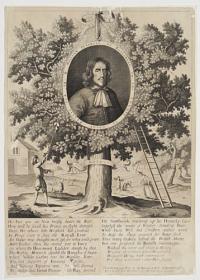
William Pendrill of Boscobell in the County of Salop Aetis Suae 84 The Royall Oake. His face you see. Now breifly heare the Rest.; How well he serv'd his Prince in flight destrest. Twas , He whose little Household did Combine In Piois Care to save : the Royall Line. An Oake was thought most safe:for what could prove More Luckie tthen the sacred tree to Love. See where the Hen=roost Ladder stands; by that, The Might Monarch climb'd the Boughs of Statem Where Noble Carlos lent his Manlike Knee, The last support of Fainting Majestie, and Natures Tapistrie was the onely Shroud To shelter that Great Prince was Rage pursu'd. The Nutthook reaching up his Honely fare supply'd the want of Waiters standing Bare; Shile busie Wife and Children gather Wood To dress the Sheep prepar'd for Better food Thus, Many Oakes defend the British Maine but one Preferr'd the Brittish Soveraigne. "Pendrill thy name will shine in History /Brighter then their's whose Hospittallity / Disguised Deitys hath entertayn'd / for thine was reall t'other Poets saynd."
From the very rare print in the possession of A H Sutherland Eq.r. Are to be sold by S. Woodburn, St. Martin's Lane, London.
Engraving. Sheet: 250 x 350mm, (9¾ x 13¾). Repaired and laid on conservation paper. Damaged. Trimmed.
A portrait of William Pendrill set in an oak. Pendrill was one of five brothers: George; Richard; Humphrey; John and William who helped Charles II escape from England after his defeat at the Battle of Worcester in 1651 during his failed attempt to regain control of England from Cromwell. The Pendrills were a Royalist family who lived and worked on the estate of Boscobel House where the King sought refuge after his defeat. Having been forced to hide in an oak tree in order to escape Cromwell's troops Charles and the Royalist Colonel Carlos finally managed to escape disguised as land workers and escorted by the Pendrills. The Pendrill brothers were richly rewarded when Charles II was restored to the throne in 1660.
[Ref: 39939] £170.00
(£204.00 incl.VAT)
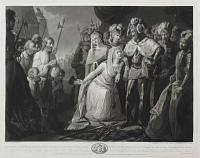
Philippa, Queen of Edw.d III, soliciting him for the lives of the six devoted Citizens of Calais, A.D. 1347. Acta Historica Reginarum Angliae. Plate III. Engraved from the Original Drawing, of the same dimensions in the Possession of Mr. V. Green. To Her Royal Highness Princess Augusta Sophia, This Plate is, by Permission, Most Humbly Dedicated, by Her Royal Highness's Most Devoted and Obedient Servant Valentine Green.
Drawn by J. Gerhard Huck, 1785. Engraved by V. Green Mezzotinto Engraver to his Majesty & the Elector Palatine.
Publish'd January 18th, 1788, by V. & R. Green No. 29 Newman Street, Oxford Street, London.
Fine mezzotint, platemark 490 x 625mm (19¼ x 24½"). Slight creasing on left. Uncut, large margins.
Philippa of Hainault, Queen consort of Edward III, soliciting her husband to release the Burghers of Calais. After the successful siege of Calais by Edward III, the city parleyed for surrender. Edward offered to spare the city on the condition that six of its leaders surrendered themselves to him, which they did. However, Philippa persuaded her husband not to execute these citizens, claiming their deaths would be a bad omen. The episode also inspired Rodin's famous sculpture 'The Burghers of Calais', one cast of which stands near the Houses of Parliament in London. Plate three of 'Acta Historicae Reginarum Angliae' by the celebrated mezzotinter Valentine Green (1739-183) from drawings by his former student Johann Gerhard Huck (c.1759-1811), with parallel text in French. Whitman: 250 II of II; CS: 153.3. Ex Collection of Hon Christopher Lennox-Boyd.
[Ref: 23047] £260.00
(£312.00 incl.VAT)
![[Edward Prince of Wales presenting the Captive King John of France & his Son to his Father Edward the 3rd.]](img-thumbnail/jpegs/25922.jpg)
[Edward Prince of Wales presenting the Captive King John of France & his Son to his Father Edward the 3rd.]
J.F. Rigaud R.A. pinxt. F. Bartolozzi R.A. Sculpt.
London, Published Feby. 14 1788 by W. Palmer No. 103 Strand.
Stipple and etching, scratched-letter proof before title printed in brown ink, 340 x 405mm. 13½ x 16". One vertical crease and some light spotting. Good margins.
The Battle of Poitiers was fought between England and France on 19 September 1356 near Poitiers, central France, resulting in the second of the three great English victories of the Hundred Years' War: Crécy, Poitiers, and Agincourt. Here Edward of Woodstock, Prince of Wales ('The Black Prince', 1330 - 1376), kneeling in armour, presents his Prisoner of War John II of France (1319 - 1364), to his father, King Edward III of England, enthroned at centre. After John Francis Rigaud (1742 - 1810). De Vesme 520, IV of V.
[Ref: 25922] £180.00
(£216.00 incl.VAT)

Great Meeting of the Political Unions, on New-Hall Hill, Birmingham, May 1832.
Green Del.t. Garnier sc.t.
London, Thomas Kelly [n.d., c.1835].
Engraving. Sheet: 215 x 285mm (8½ x 11¼"), with very large margins. Creasing. slight repair outer top margin.
In 1831 Grey's reform bill passed in the house and it was sent to the Lords. In May the Birmingham Political Unions gathered at Newhall Hill to put pressure on the Lords to pass the bill but it was rejected and large scale rioting took place throughout the country.
[Ref: 47508] £75.00
(£90.00 incl.VAT)
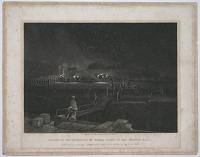
Escort of the Prisoners by Torch Light to the Bristol Jail, Tried (under a Special Commission) for Riot & Arson in the Year 1832.
Engraved on Steel by J. Brett, 15, Corn Street, Bristol.
Published by George Davey 1, Broad Street, Bristol, and by Charles Tilt, Fleet Street, London, and all other Book & Printsellers.
Mezzotint on india laid paper, 235 x 305mm. 9¼ x 12".
A scene from the aftermath of the Bristol Riots of 1831, after the House of Lords rejected the second Reform Bill, which aimed to get rid of some of the rotten boroughs and give Britain's fast growing industrial towns such as Bristol, Manchester, Birmingham, Bradford and Leeds greater representation in the House of Commons. The rioters numbered about 500 or 600 young men and continued for three days, during which the palace of Robert Gray the Bishop of Bristol, the Mansion House, and private homes and property were looted and destroyed, along with demolition of much of the gaol. About 100 people involved were tried in January 1832 and four men were hanged despite a petition of 10,000 Bristolian signatures, which was given to King William IV.
[Ref: 15397] £130.00
(£156.00 incl.VAT)
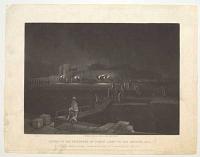
Escort of the Prisoners by Torch Light to the Bristol Jail, Tried (under a Special Commission) for Riot & Arson in the Year 1832.
Engraved on Steel by J. Brett, 15, Corn Street, Bristol.
Published by George Davey 1, Broad Street, Bristol, and by Charles Tilt, Fleet Street, London, and all other Book & Printsellers.
Mezzotint on india laid paper, sheet 235 x 305mm (9¼ x 12"). Some light creasing. Nicks to edges of paper. Slight soiling.
A scene from the aftermath of the Bristol Riots of 1831, after the House of Lords rejected the second Reform Bill, which aimed to get rid of some of the rotten boroughs and give Britain's fast growing industrial towns such as Bristol, Manchester, Birmingham, Bradford and Leeds greater representation in the House of Commons. The rioters numbered about 500 or 600 young men and continued for three days, during which the palace of Robert Gray the Bishop of Bristol, the Mansion House, and private homes and property were looted and destroyed, along with demolition of much of the gaol. About 100 people involved were tried in January 1832 and four men were hanged despite a petition of 10,000 Bristolian signatures, which was given to King William IV. See also reference 15397.
[Ref: 60046] £130.00
(£156.00 incl.VAT)
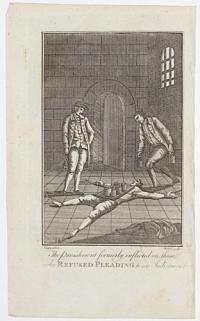
The punishment formerly inflicted on those who Refused Pleading to an Indictment.
Vangroddin. Roberts sculp. [c.1770]
Engraving, sheet 210 x 125mm (8 x 4¾"). Large margins on 3 sides.
[Ref: 46578] £70.00
(£84.00 incl.VAT)
![The Resignation of Lady Jane Grey. [&] The Magnanimity of Mary Queen of Scots.](img-thumbnail/jpegs/38018.jpg)
The Resignation of Lady Jane Grey. [&] The Magnanimity of Mary Queen of Scots.
[After William Hamilton.]
[n.d., c.1788.]
Hand coloured stipple. Pair in titled Verre églomisé frames. Printed area: 295 x 295mm (11¾ x 11¾") each. Frame size: 460 x 460mm (18¼ x 18¼") each. Unexamined out of frames.
The Queen, on route to her execution, accompanied by her weeping ladies and a boy, led by two men, stops to address her steward Melville, an old man who kneels on the right, telling him not to grieve, since her troubles are nearly over. [&] Lady Jane Grey sitting on the left with her ladies at a table with an open book, holding up a crown, turning her head to look happily towards the Duke of Suffolk who enters to the right, bringing news that the council had declared for Queen Mary. Titles within frames do not match the images.
[Ref: 38018] £490.00
view all images for this item
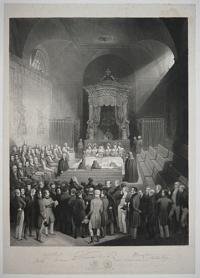
The Reform Bill receiving The King's Assent by Royal Commission. Proof.
Engraved by Will.m Walker & Sam.l W. Reynolds from a picture taken on the spot by the late S.am.l W. Reynolds Esq.re when the Assent was declared. _ The Portraits from Original and Authentic Sketches.
William Walker Excudit, June 1836, No 64 Margaret Street, Cavandish Square London, & 22, London Street, Edinburgh.
Mezzotint on india, proof. 850 x 605mm (33½ x 24½"). Laid on board. India slightly trimmed at bottom, losing part of secondary publication line.
The House of Lords on 7th June 1832, during the passing of The Great Reform Act, with distinct portraits of the notable characters. In the inscription area are the facsimile signatures of William IV (although he was not present), Grey, Holland, Durham, Brougham, Landsdowne and Wellesley.
[Ref: 27837] £520.00
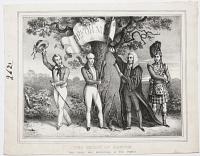
The Spirit of Reform. The King. His Ministers. & The People.
[Published by Gabriel Shire Tregear, 1831]
Lithograph, rare, sheet 205 x 265mm (8 x 10½").
In front of a tree, a gentleman holding a banner, a sailor to his right, a lawyer holding a document to his left and a guardsman in highland dress far left. Windsor castle in background. Head of the King William IV in trees.
[Ref: 43943] £120.00
(£144.00 incl.VAT)
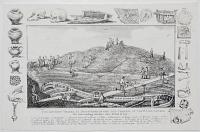
The Ancient Vessel, &c, Discovered in the Old Channel of the River Rother. The surrounding Articles were found in her.
[House?] del Fulham. J. Boosey & Co. Lithog. 310 Strand.
[n.d., c.1822.]
Lithograph. Sheet: 140 x 215mm (5½ x 8½").
A view of the excavation of a 14th century boat in Sussex, the central image is surrounded by articles found in the boat.
[Ref: 47501] £60.00
(£72.00 incl.VAT)
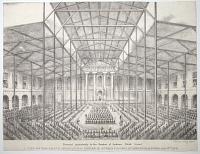
A View of the Grand Agricultural Dinner in Queen's College Quadrangle, Oxford, July 17th 1839. Presented gratuitously to the Readers of Jackson's Oxford Journal.
Plowman Lithog. Oxford.
[c.1839.]
Rare lithograph. Sheet 290 x 380mm (11½ x 15"). Trimmed to image.
The first meeting of the Agricultural Society of England, a year before a Royal Charter of Incorporation changed the name to the Royal Agricultural Society. Held in a specially-constructed pavilion, the dinner seated 2,500.
[Ref: 52207] £320.00
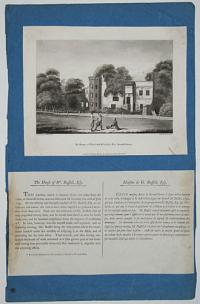
The House of William Russel, Esq. Showell Green. The House of W. Russell, Esq. This mansion, which is situated about two miles from the town, at Showell-Green, was not destroyed till Saturday the 16th of July 1791. By the activity and intrepid conduct of W. Russell, Esq. its inhabitant owner, the rioters were either repelled or persuaded to retire, more than once... Aussi-tôt après la maison ayant été pilleé du restant de ses meubles (la majeure partie ayant été démenagée auparavant) fut incendiée ainsi que toutes ses dépendances.
Drawn by P.H. Witton Jun.r Engraved by W.m Ellis.
London. Published, 1 May 1792, by J.Johnson, St. Paul's Church Yard.
Aquatint with descriptive text in English and French. Sheet 406 x 260mm. 16 x 10¼". Laid on album page, foxing.
William Russell (1740-1818) was a practising Unitarian Dissenter, close friend and sponsor of Joseph Priestley. Rioters therefore attacked his house, on 16th July 1791, during the Priestley Riots, the Birmingham Riots of 1791, which targeted religious Dissenters, most notably the politically and theologically controversial Joseph Priestley. From "Views of the Ruins of the Principal Houses destroyed during the Riots at Birmingham. 1791." On the 14th of July, 1791, a party having met at an hotel to celebrate the anniversary of the French revolution, collected together as a mob, and proceeded for several days their devastations, setting fire to several meeting-houses and private mansions, but on the arrival of the military from Oxford and Hounslow, order was restored: at the ensuing assizes four of the ring-leaders were convicted, two of whom suffered the penalty of the law. Shortly after this occurrence barracks were erected on the Vauxhall-road, near the town, consisting of a range of handsome buildings, enclosing a spacious area for the exercise of cavalry, and a smaller for parades, a riding-school, a magazine, and an hospital.
[Ref: 21108] £160.00
(£192.00 incl.VAT)
![First Russian Prisoners. (under French Guard) [&] First Russian Prisoners. (under English Guard).](img-thumbnail/jpegs/37412.jpg)
First Russian Prisoners. (under French Guard) [&] First Russian Prisoners. (under English Guard).
[n.d., c.1850.]
Chromolithographs. Sheet size: 165 x 190mm (6¾ x 7½") each. Both trimmed around image and titles and laid on backing sheets.
Russian prisoners under the guard of, firstly, French soldiers; the prisoners, one of which are badly injured, are gathred in a cart pulled by cattle, surrounded by soldiers in military dress holding bayoneted rifles. Figures looking on can be seen at the side of the street in the background to the left. Russian prisoners under the guard of English soldiers in Constantinople; the prisoners are in a small boat travelling sailing aong river, with a brige, crowded with people, crossing behind, with another boat passing under it.
[Ref: 37412] £120.00
(£144.00 incl.VAT)
view all images for this item
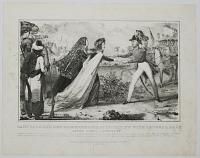
Lady Sale and her Daughter's First Interview with General Sale After Their Captivity. From an Authentic Sketch by an Officer Taken at the Time Representing the Joyful Meeting of the Heroic Lady Sale Mrs Sturt Her Daughter and the Other Cabul Prisoner s with General Sale and His Brigade at Takhan Near Cabul 20th Sept Attended by Saleh Mahommed Khan and Other Faithful Afghans.
Drawn on Stone by Richard Eran Sly 40 Upper Seymour St Euston Sq.re.
Published by Blackwood & Page 154 Strand May 27th 1843. Printed by W. Kohler.
Rare lithograph. Sheet: 220 x 285mm (8¾ x 11¼''). Repaired tear.
A historical scene showing the release of women including Florentia Sale and her daughter Alexandrina Sturt after nine months capture. General Robert Sale was commander of the British forces at Jalalabad during the 1st Afghan War. In 1842 Afghan commander Akbar Khan captured a group of British women, children and soldiers after the massacre of Khurd Karbul Pass. As well as Mrs Sale's daughter her son-in-law Lt. John Sturt was captured; however he had been wounded and died in captivity.
[Ref: 49941] £140.00
(£168.00 incl.VAT)
![[The seven bishops imprisoned in the Tower of London by James II in June 1688]](img-thumbnail/jpegs/42799.jpg)
[The seven bishops imprisoned in the Tower of London by James II in June 1688] De Seven Bischoppen naar den Tour gevangen gebragt den 8/18 vry gelaaten den 15/25 Juny 1688.
Apud Carolum Allard Cum Privi: Ord: Holl: et Westfri: [c.1700]
Etching, rare; sheet 250 x 295mm (9¾ x 11½"). Tipped into album sheet; fold through centre. Trimmed to border.
View on the Thames with Tower Bridge on left and London Bridge (incorrectly) on right, showing the Seven Bishops imprisoned by James II for seditious libel over their opposition to the second Declaration of Indulgence. The bishops were: Thomas White, Bishop of Peterborough; Francis Turner, Bishop of Ely; Sir Jonathan Trelawny, Bishop Exeter and Winchester; John Lake, Bishop of Chichester; Thomas Ken, Bishop of Bath and Wells; William Lloyd, Bishop of Worcester; and William Sancroft, Bishop of Canterbury. The bishops were acquitted, to James II's disappointment but to universal rejoicing amongst his subjects. Plate from a Dutch publication comprising twenty plates depicting key episodes from the Glorious Revolution. For portraits of the Seven Bishops see refs. 23975, 23977, and others.
[Ref: 42799] £320.00




![Reception of Her Royal High. The Princesse of Orange as queene of Great Britain [parallel text in Dutch]](img-thumbnail/jpegs/42379.jpg)
![[Departure of Marry II from Holland.] Vetrek van haar Koning lyke Hoogheid Mevrouw de Prinses van Oranjen uit Holland den 20 Februar 1689.](img-thumbnail/jpegs/42942.jpg)
![[Mary II on her deathbed, with William III grieving and courtiers offering condolences]](img-thumbnail/jpegs/42798.jpg)
![[Title page to series of prints depicting the funeral of Mary II]](img-thumbnail/jpegs/42807.jpg)
![[The funeral of Mary II] Bed van Parade [...]](img-thumbnail/jpegs/61405.jpg)
![[The funeral of Mary II] Lectisternium Ostentiserum. Bed van Parade [...]](img-thumbnail/jpegs/42576.jpg)
![[Entrance to Whitehall Palace during preparations for the funeral of Mary II]](img-thumbnail/jpegs/42595.jpg)
![[Mary II on her deathbed]](img-thumbnail/jpegs/42808.jpg)
![[Burial of Mary II at Westminster Abbey]](img-thumbnail/jpegs/42809.jpg)
![[Funeral Procession of Mary II]](img-thumbnail/jpegs/42810.jpg)

![[Departure of Mary Queen of Scot's to France, when a Child.] [&] [Mary, Queen of Scots Leaving Scotland]](img-thumbnail/jpegs/56632.jpg)


![[James Scott, Duke of Monmouth greeting his supporters.]](img-thumbnail/jpegs/42794.jpg)




![[Lord Nelson] The Magnificent Funeral Car.](img-thumbnail/jpegs/61303.jpg)
![[Funeral Procession of Lord Viscount Nelson, Jan.y 9th 1806.]](img-thumbnail/jpegs/39092.jpg)




![[Never-extinguished flame]](img-thumbnail/jpegs/47102.jpg)

![[The English Parliament in Session; Edward I (?) presiding.]](img-thumbnail/jpegs/26869.jpg)
![A View of the House of Peers, the King sitting on his Throne, the Commons attending him at the end of ye Session 1741-2 [...]](img-thumbnail/jpegs/38479.jpg)
![[Parliament in session at Westminster Hall, 1689]](img-thumbnail/jpegs/42597.jpg)


![[Edward Prince of Wales presenting the Captive King John of France & his Son to his Father Edward the 3rd.]](img-thumbnail/jpegs/25922.jpg)




![The Resignation of Lady Jane Grey. [&] The Magnanimity of Mary Queen of Scots.](img-thumbnail/jpegs/38018.jpg)





![First Russian Prisoners. (under French Guard) [&] First Russian Prisoners. (under English Guard).](img-thumbnail/jpegs/37412.jpg)

![[The seven bishops imprisoned in the Tower of London by James II in June 1688]](img-thumbnail/jpegs/42799.jpg)